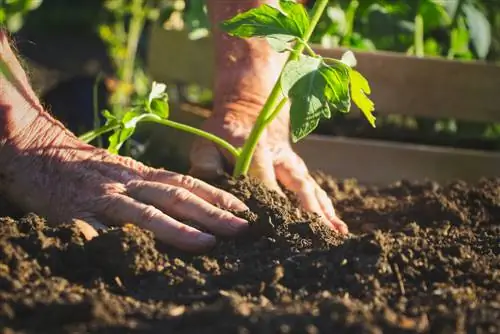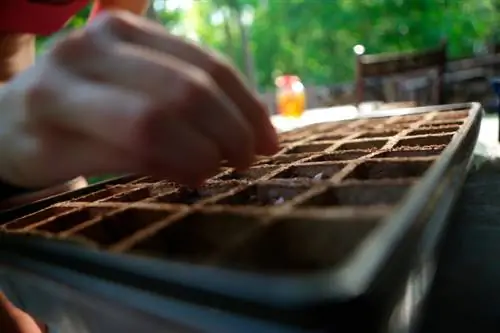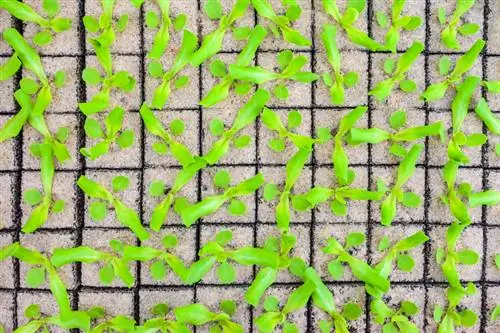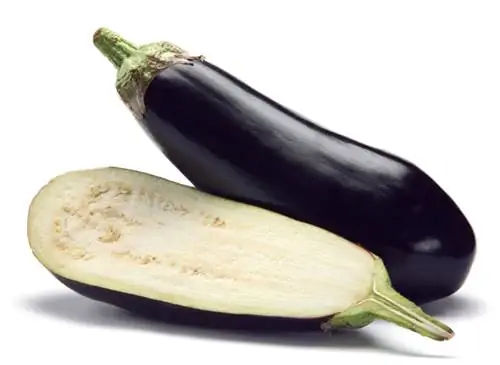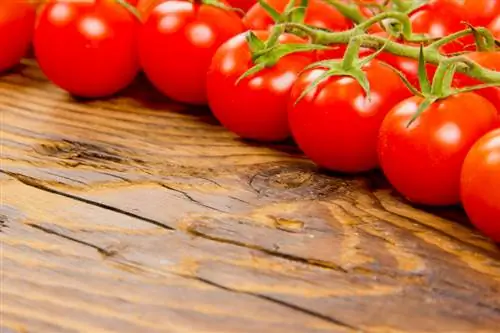- Author admin [email protected].
- Public 2024-01-02 03:03.
- Last modified 2025-01-23 11:19.
Your tomato plants are grown and ready to be planted out in mid-May. However, from the right location to soil preparation, there are a few things you should keep in mind to ensure a good harvest.
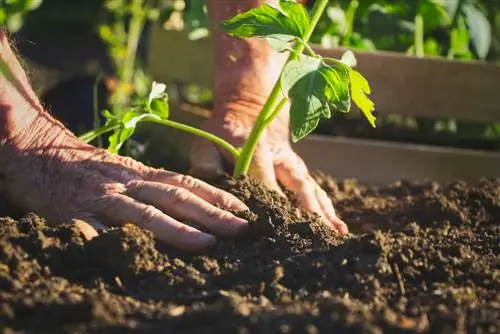
How to plant tomatoes correctly?
To plant tomatoes successfully, you should place them in a sunny location from mid-May after the Ice Saints at a distance of 60 cm or in at least 15 liter pots. Use compost or horn shavings as starter fertilizer and give the plants a climbing aid.
Sowing to Harvest: Development of a Tomato Plant
The development of the tomato plant begins with sowing the seeds between March and April and cultivating them on the windowsill. The subsequent cultivation phase ends with the formation of the first pair of leaves after around five to six weeks and a size of around ten centimeters. However, planting outdoors should not take place until mid-May after the Ice Saints at the earliest to avoid frost damage. By then, the young plant should have reached a size of around 15 centimeters and have several pairs of leaves. After planting, the growth of the tomato increases steadily up to a maximum size of two meters.
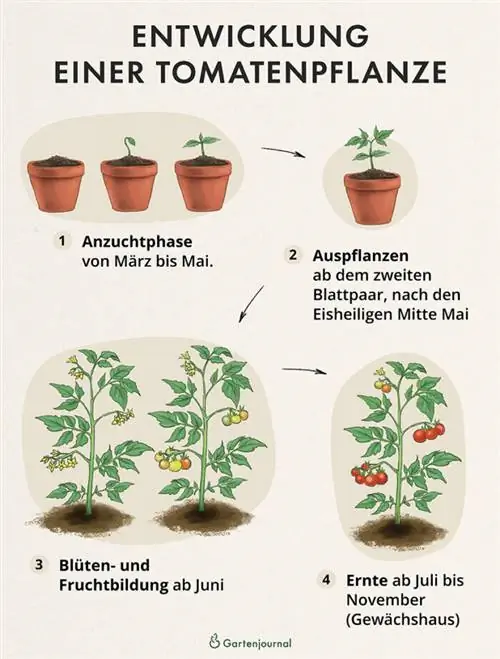
Other milestones in tomato cultivation are:
- Flower training: from mid-June
- Fruit training: from June to August
- Harvest time: Ripening time varies depending on the variety, harvest possible from August to October
Instructions: Planting Tomatoes
When planting tomatoes, there are a number of individual factors to consider. All the information relevant to you as a gardener is clearly compiled below.
The right time to plant out
The right time to plant tomatoes outdoors essentially depends on the location chosen and the type of planting. A fundamental distinction must therefore be made between specimens cultivated in the greenhouse, in pots and in the open field. However, the temperature should never fall below 10 degrees Celsius. In practice, the following times have proven to be effective:
- Greenhouse: if the size is appropriate, already from mid-April
- Pot: in sheltered locations from the beginning of May
- Freiland: after the Ice Saints from mid-May
The right location
The right location is a guarantee for abundant flowers and, as a result, a lush harvest. Selecting the right place to plant tomato seedlings should therefore be given particular importance.
Sun-loving tomatoes
The tomato is one of the sun-loving plants and needs an average ofseven hours of sun per day. Uniform lighting of the perennial supports constant height growth and the formation of numerous flowers. A location that is too shady will result in an increased number of leaves and weak growth.
Distances in the bed and greenhouse
When planting several young plants, make sure there is sufficient distance between the individual tomatoes. The disadvantages of planting too densely are diverse and range from stunted growth to reduced fruit production and increased susceptibility to disease. In order to provide each plant with enough space for its own growth, the following minimum distances should be observed.
- Bed in the open ground: 70 to 80 centimeters
- Bed in the greenhouse: 50 to 60 centimeters
Bed preparation
An optimally prepared location also includes the correct preparation of the planting bed. In addition to providing all the necessary nutrients, the depth at which the seedlings are planted also plays an important role in ensuring the best possible rooting.
Necessary nutrients
For uniform growth and the extensive development of flowers and fruits, a good supply of nutrients is the be-all and end-all. Since the tomato plant is a heavy feeder in terms of nutrient requirements, a constant amount of the following is required throughout the entire life cycle Minerals needed.
Calium (calcium): Calcium forms the basis of a balanced water balance and is an essential component of photosynthesis. The mineral promotes the development and ripening of the fruits.
Nitrogen: The nutrient is the main component of the plant's own proteins and chlorophyll and is necessary for the plants' steady growth.
Sulfur and magnesium: The two substances are elementary building blocks for the production of chlorophyll. They regulate metabolic functions.
Phosphor: This substance stabilizes the immune system and metabolic processes. Phosphorus promotes root and flower formation.
Planting depth
To support the establishment of the young plants in the soil, the seedling should be planted at a depth ofat least five to seven centimeters. Basically, you can plant your tomato plantsdown to the lowest pair of leaves In combination with a slightly slanted transplant, rooting is optimally stimulated and greater stability is achieved.
Neighbors
Due to their classification as heavy eaters, not all types of vegetables are suitable for planting together with tomatoes. Due to the high requirements in terms of nutrients, light and irrigation, tomato plants are particularly suitable for those who eat poorly.
Good neighbors: Good neighbors for tomatoes include herbs like basil and savory. Strawberries, garlic and salads are suitable vegetables.
Bad neighbors: Bad neighbors for tomatoes are beans, fennel, cucumbers, peas and potatoes. The latter can be carriers of late blight and brown blight. For this reason, tomato plants should not be successors to beds.
Watering tomatoes
The trained tomatoes consist of around 90% water, which is why good care and consistent watering of the plants is necessary both during growth and ripening of the fruits. At best, prolonged drought threatens individual tomatoes to burst, which in turn leads to increased susceptibility to disease and pest infestation. When watering, you should also make sure to only water the soil. Constant moistening of the leaves increases the development of brown rot, a dangerous fungal disease.

Clay pot with a hole in the bottom: Watering using a clay pot with a hole that is buried in the ground is one of the cheapest methods. The pot used is placed at a distance of around ten centimeters from the main stem of the tomato. Filling the vessel with water and then slowly releasing it through the hole on the bottom also avoids overwatering.
Watering ring: A watering ring (€19.00 on Amazon) is a ring, often made of plastic, that is placed around the plant. The added water remains within the mold and is only slowly released into the soil. For particularly water-loving plants such as tomatoes, watering using a watering ring is an option, although the problems of waterlogging and overwatering should not be ignored.
Olla: Olla is the technical term for a clay pot that is a practical irrigation aid. The clay used is slightly heated during production so that it retains a porous and water-permeable consistency. After the Olla has been placed in the ground and filled with water, it releases moisture evenly into the environment. This ensures constant irrigation even at high temperatures, without the risk of waterlogging. At around 30 euros per piece, the price is significantly higher compared to the original clay pot.
Fertilize tomatoes
The use of fertilizer is just as important a component of care as watering. The nutrients promote the maintenance of a strong immune system and the development of high-quality fruits. The earliest possible time for the first fertilization is when the plant issized about 15 centimeters and has several pairs of leaves. In addition, the amount of fertilizer should be adapted to the corresponding form of cultivation.
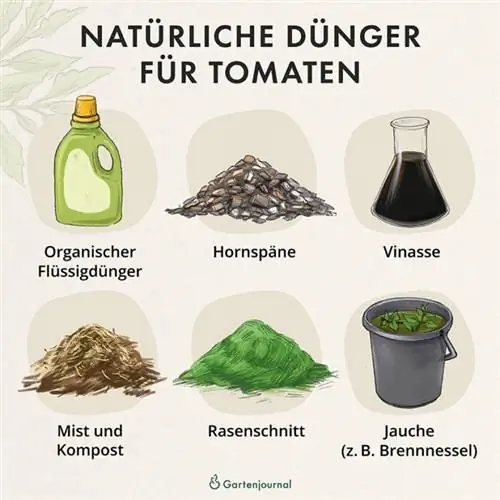
Organic liquid fertilizer: The organic liquid fertilizer is usually supplied to the plant via irrigation water every two weeks. The pre-made special mixtures are very nutrient-rich and contain all the nutrients necessary for the growth of the tomato in the correct concentration. The liquid fertilizer also serves as an additional source of moisture and is therefore particularly recommended for potted plants.
Horn shavings: The horn shavings are made from the hooves of cattle and are an excellent nitrogen fertilizer. Particularly due to the highly consuming properties of the tomato plant, they are a useful addition to a complete fertilizer. However, it should be used sparingly with an interval of at least two months between individual fertilizer applications to avoid the effects of over-fertilization.
Vinasse: Vinasse is an organic waste product of molasses production and is also often referred to as molasses stillage. The residual sugar it contains serves to strengthen the soil's own microorganisms and improve the value of the substrate. The liquid is also characterized by a high potassium content, so it is particularly suitable for those who are undersupplied.
Horse manure: The nutrients contained in horse manure optimally cover the needs of the tomato plant, which is why it can be used as a complete fertilizer. However, only stale material is suitable for incorporation into the bed, as fresh manure releases enormous amounts of heat as it decomposes, which can lead to burns.
Lawn clippings: Lawn clippings are one of the most cost-effective fertilization options because they are a waste product of regular lawn mowing. You can distribute the separated grass blades around the plants; they do not need to be worked into the soil.
Stinging nettle manure: Nettle manure is made from an infusion of rainwater and nettle leaves. In addition to the high nutrient density of the complete fertilizer, the manure also serves as a natural pest control agent, but should never be administered undiluted.
Protecting tomato plants
Tomato plants are very sensitive to both rain and wind, which is why they need to be protected from the elements. While no additional measures need to be taken when cultivating in a greenhouse, specimens transplanted into pots can be placed in a protected location. However, tomatoes transplanted outdoors require an additional stable protection mechanism if they do not belong to the resistant varieties.
- Tomato hood: plastic bag that is placed over a single plant
- Tomato house: plastic film that is erected over several plants using a scaffolding
Trails for tomatoes
Since the tomato plants can reach a height of up to two meters, it is necessary to support the fruit-bearing shoots well. Depending on the variety, different climbing aids have proven successful in practice.
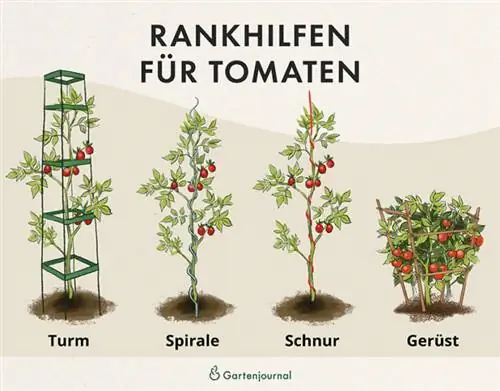
Tomato Tower: The tomato tower is a three- to four-legged plastic structure that is placed over the tomato plant. The height of the towers varies from one meter to two meters, making them particularly suitable for tall varieties. Due to the simultaneous support of the cross shoots, additional fastening is not necessary.
Tomato spiral: The tomato spiral is a spiral-shaped metal rod that is inserted into the soil next to the main shoot. To achieve high stability, the middle shoot is wrapped evenly around the spiral. The side shoots are not additionally supported in this variant, which is why it is only recommended for single-shoot tomatoes.
Tomato string: Using a tomato string requires attaching a hook above the planting site. A solid string is attached to this, which in turn is looped around the main shoot of the tomato. The variant is also only suitable for single-drive models, whereby the maximum load capacity should not exceed five kilograms.
Tomato frame: The tomato frame is a frame made of wood into which the tomato is placed. Due to its compact shape, this climbing aid is used in practice primarily for wild tomatoes, which already naturally grow very bushy and only reach a low height.
Cutting and stripping tomatoes
If tomato plants grow too tall, they can be trimmed. It is also recommended to remove the lower leaves to avoid waterlogging. Removing the stingy shoots is an equally essential activity in tomato care, but is not recommended for every tomato variety. The shoots that grow out of the leaf axils usually do not produce flowers or fruits, but they still deprive the plant of nutrients.
Read how to properly prune your tomato plants.
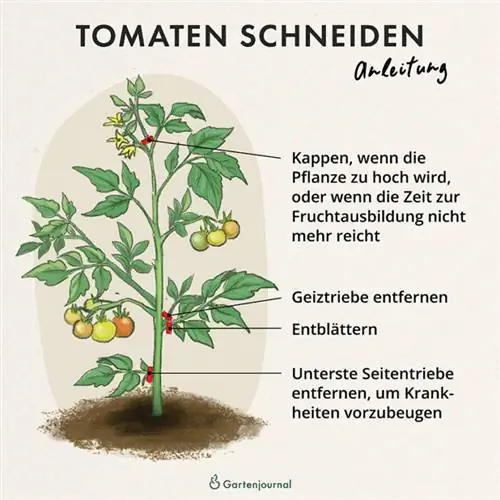
FAQ
Do tomatoes need sun?
Tomatoes need at least seven hours of sun per day for both uniform growth and the formation of flowers.
Why aren't my tomatoes blooming?
The lack of flowering is often due to inappropriate care such as over- or under-fertilization or an insufficient amount of water.
Why do my tomatoes droop their leaves?
The most common cause of drooping leaves is a lack of water, but this can be remedied within a few days with appropriate watering.
How deep do tomatoes root?
The tomato roots reach a depth of up to one meter, which is why they are botanically classified as deep-rooted plants.
Can I overwinter tomato plants?
Due to the high light and heat requirements of tomatoes, overwintering is hardly possible in this country. However, if you place the plant in a bright and warm location over the winter, overwintering is generally possible.

